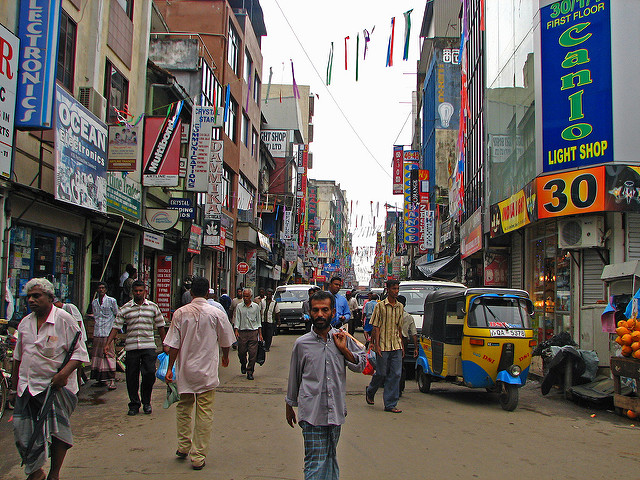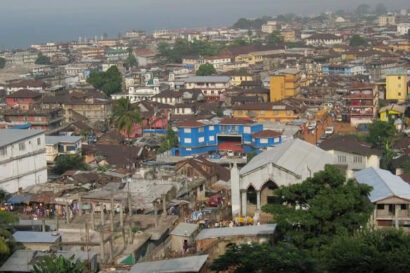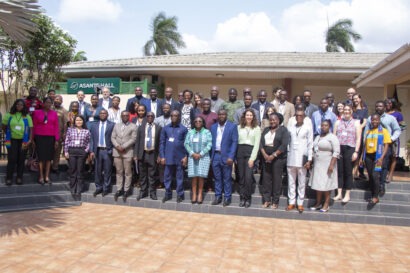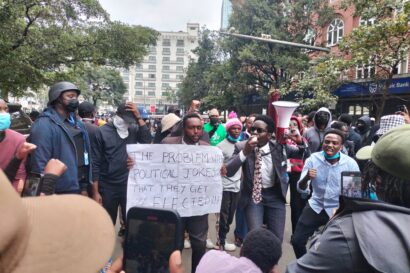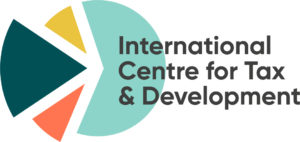The government of Sri Lanka is negotiating a large conditional loan from the IMF. A formal agreement is likely to be signed within weeks once all the main creditors provide the IMF with adequate assurances that they will write off some of the government’s outstanding debt and will not seek to exploit any future economic uplift to demand priority repayment of their own loans.
But Sri Lanka’s politicians are very divided over the idea of signing any agreement with the IMF. On the one side, the government is asserting that an agreement is essential, that it should not be considered a political issue and that the government itself needs to be given a great deal of policy discretion so that it can meet IMF demands. On the other side, most of the political left is opposed to any agreement with the IMF, commonly on the grounds that this in reality would constitute another (neo-liberal) attempt by coalition of international finance capital, the IMF and the US government to take control of economic policy and extract yet more profit from the Sri Lanka people. Another left argument is that Sri Lanka has entered into many IMF programmes before. None of them fundamentally cured Sri Lanka’s economic problems so there is no reason to expect this one to work.
This political and ideological polarisation is counterproductive and likely to cost Sri Lankans a great deal in term of increased hunger, higher levels of mortality, lost education and long term poverty. My best guess is that the IMF agreement will be signed but the government will not stick closely to its side of the bargain. It will not raise the additional revenue promised, cut corners in various ways, continually promise to perform better in the next financial quarter and do its best to keep the IMF in the dark about some key economic and fiscal statistics. The IMF will tolerate this for some time, not least because it has a strong self-interest in not appearing to be excessively tough on small countries and in not terminating programmes while they appear to have some chance of success. But eventually one side or the other will call time on the agreement. That prediction is rooted in history. Globally, 38% of IMF programmes were terminated prematurely over the period 1980-2015. The historical figure for Sri Lanka is a little higher, and close to 50%. Over the 54 year period from 1965 to 2019, Sri Lankan governments signed 16 agreements for IMF assistance. Those agreements were in place for 28 years. Seven of them were terminated early. The most recent agreements were in 2003, 2009 and 2016. In each case the government committed to increasing public revenue as a proportion of GDP. In each case, the revenue targets were missed by a mile. It is already clear that the revenue targets for 2023 set by the current government in preparation for the next IMF agreement are likely to be undershot by around 10%.
An agreement with the IMF in 2023 that sputtered along for two or three years before termination would not be the worst possible outcome for Sri Lanka. The country will at least have received a large initial injection of foreign exchange to help revive the economy. But neither would it be a good outcome. Important reforms, including revenue reforms, will be far from complete. The government will again sink in the credit ratings and find it hard to borrow foreign exchange at reasonable rates. We could be back to severe import restrictions, fuel queues, and fertiliser scarcity and thus to higher levels of undernutrition, increased mortality, more lost schooling and deeper poverty.
There is a better way. That necessarily involves some kind of agreement with the IMF. The economy is greatly underperforming and the people suffering because the government has no access to the credit it needs to import sufficient food, fertiliser, fuel and all those other things needed to get the economy humming again. At present there is no alternative source of credit. Private capital will not lend because the government is in serious default on its existing loans. Private lenders may come back once they have sufficient assurance, as measured mainly the existence of an IMF agreement, that the government is on a sufficiently stable fiscal path that it will eventually be able to repay any new loans that are granted. Official lenders such as China, India, Japan, the Asian Development Bank and the World Bank take essentially the same view. The underlying dynamic is simple: no potential lender, public or private, will loan money to a government that has no prospect of raising sufficient revenue to repay the loans and the interest at some point in the future and/or shows no serious sign of beefing up its revenue machinery to be able to repay. That dynamic will remain even if various great powers and global organisations surprise us and write off a large proportion of the government’s current outstanding debts.
The key term is however some kind of agreement with the IMF. There is much more scope for Sri Lanka to negotiate about this than either the current government or the left suggest. The IMF has become a much more empathetic, pragmatic and flexible organisation than it was when it earned a reputation for rigid and heartless insistence on austerity and public spending cuts as a cure for all macroeconomic problems. The IMF also knows that its country programmes often fail because they lack domestic political support and because they are often badly designed; the governments on the receiving end rely too much on the IMF but the IMF does not have detailed country knowledge. The IMF could be persuaded to embrace or at least accept progressive or radical policies that would directly help solve the current economic crisis, distribute the costs much more equitably among the population, and appear fair and reasonable to many Sri Lankans. The gleam in my eye is a nationally-defined economic policy programme that effectively addresses the fiscal crisis, is and is seen to be equitable, and has significant popular support. The greater that political support, the greater the bargaining leverage the government will have over the IMF.
This aspiration is optimistic but realistic. How do we achieve it? We need to start by dropping any notion of the IMF as some all powerful bogeyman working hand in glove with international capital to squeeze the poor of the world. If the IMF were that powerful, it would be able to enforce the agreements that it signs with governments. In reality, a large proportion fail, almost all because national governments don’t uphold their end of the bargain. The IMF is powerful but it is ultimately just another international organisation struggling to for continued existence and funding amid competing political pressures, notably between the governments that provide it capital and those that borrow, and between the West, China and Russia. The IMF suffers one systemic weakness in relation to its borrowers. Its loans are made in more or less emergency situations. They typically involve large up-front capital injections. Once governments have that upfront money, their incentives to honour all the promises they made about revenue, spending and reform are blunted.
The IMF itself has changed considerably since the latter part of the last century and the first decade of this when what appeared to be standard policy packages gave birth to the narrative about its merciless and unyielding insistence on public spending cuts in all circumstances. Over the past decade or more it has, through its research and publications and the speeches of its leading figures, become one of the most influential global advocates of greater income and gender equality in the interests of economic growth, and more effective social protection for the poorest, through direct public action. It is probably relevant that the managing director post has been held by a woman since 2011 (Christine Lagarde and now Kristalina Georgieva) and the first female Chief Economist was appointed in 2019 (Gita Gopinath).
We do not yet know the details of the agreement that the government is likely to sign with the IMF. But we do know the outlines. The package does not conform at all to the narrative of savage public spending cuts. There will be spending cuts, although the current government has already sensibly pre-empted some of them by dialling back on the massive infrastructure projects that formed the centrepiece of the economic policy of the Rajapaksa governments. There are clearly also hints from Washington about the scope for saving public money by cutting back on the excessively large armed forces and defence budgets. What is not to like about that? Otherwise, the IMF simply does not see much scope for cutting public spending without causing economic, social or political damage.
The most interesting parts of the draft agreement are more constructive. The IMF has positively encouraged the government to establish a serious cash transfer programme to protect the poorest Sri Lankans during the current crisis. The government has formally made preparatory moves, but in a very unconvincing way (see below). The IMF also emphasises increasing government revenue, which is essential for long term economic stability, and privatising those state owned enterprises that cause government large recurrent financial losses. Both are of course controversial: revenue because of the way the government has appeared to load all the burden on personal income taxpayers; and privatisation partly on principle and partly because previous privatisations directed by the current President had more than a whiff of scandal around them. We also know that the IMF is at least contemplating introducing into the agreement broad governance conditions that would probably be popular if they were not tainted by implications of violated national sovereignty.
On balance, the IMF has a more progressive attitude to the policies needed to tackle the current crisis than does the current government. There is scope for a government to take advantage of this situation by committing, in deeds as well as words, to an economic adjustment programme that would be more effective and visibly much more equitable. If communicated well, such a programme could become relatively popular. The more popular it is, the stronger the bargaining position of the government in relation to the IMF. The IMF might be willing to tolerate or even embrace an even more progressive stance. What might that more progressive nationally designed programme look like? Here are three important potential components.
A real safety net for the poorest
In mid 2022, in the early stages of the IMF negotiations, the government announced that it would fold the existing Samurdhi scheme into a much larger programme to transfer Rs7,500 monthly to the most vulnerable households. This was anyway long overdue. The Samurdhi scheme has for many years been shamefully inadequate for a country that had attained the formal status of a middle income country before losing it again in 2022 because of collapsing income levels. Samurdhi has been well researched and found to be woefully inadequate even before the pandemic and the economic crisis. It covers just 27% of households in Sri Lanka and systematically excludes over 58% of eligible recipients. The administrative costs are high because it is also, and perhaps primarily, an employment programme for Samurdhi officers. Many recipients are not formally eligible. In July 2022, Verite Research published a paper that showed in detail that there is a very high overlap between household incomes and the amount of electricity used. It would be possible to bypass Samurdhi and quickly establish basic eligibility for an effective cash transfer programme by using records of electricity use. These are available for 99% of households. The government did no such thing. It instead announced that it was undertaking a national household survey to determine eligibility for the new cash transfer programme. Nothing was said publicly about the criteria that would be used to determine eligibility or how this process would avoid the high levels of politicisation and personalism that have undermined Samurdhi. The survey seems to have taken much longer than expected. In January of this year it was announced that the survey was still ongoing; the cabinet agreed that the new welfare payments will begin in May. At the same time, it was announced that the government would, for a period of two months, give 10 kg of rice per month to two million low income families, including Samurdhi beneficiaries. Given the logistical challenges of distributing rice in this way and the learning costs involved, it seems idiosyncratic to create such a programme just for a two months period. Perhaps the government does not seriously intend to establish an effective safety net for the poor but rather to delay, confuse and prevent the political opposition from mobilising around this issue? The World Bank’s Colombo office has for many years been urging the government to establish a proper safety net for the poor. It would likely join the IMF in celebrating real steps in this direction.
Sharing the tax burden: cancel exemptions
Sri Lanka needs more public revenue. As a proportion of GDP, the government currently collects less than half of what it collected in the 1950s, 1960s, 1970s and 1980s, and less than half what one would expect of a country at this income level. The most urgent need is to assure any future lenders, public or private, that the government would be able to repay any loans it receives, including concessional loans. The more important need is to fund, long term, the public facilities and services that Sri Lankans so badly lack, starting with education and a reasonable social safety net for the poorest, including the growing number of elderly on very low incomes. But the government has increased tax resistance by increasing personal income tax in a provocative way. What might a different government do? There is actually a major potential source of increased tax revenue that could be quickly tapped without the complex and time consuming organisational and legal procedures that would be needed to set up a recurrent wealth tax. Sri Lankan companies have for decades benefitted from extremely generous tax exemptions of all kinds. The exemption system has been examined many times. The conclusions do not change much. There are too many tax exemptions for investors; they are typically justified in terms of attracting foreign investment but have failed miserably to achieve that objective. Exemptions are given mainly through direct, personal lobbying and the use of ministerial discretion. There is no good record anywhere of what exemptions have been given, their dates of expiry or the conditions attached to them. The IMF – along with the World Bank, the UN and the OECD – has long called for a cut back in exemptions for investors, globally as well as for Sri Lanka. Now is a good time for the government to respond by simply cancelling all tax exemptions for investors and applying a single VAT rate and a single corporate income tax rate to all companies. Because there are currently so many exemptions and so many companies at present pay little or no income tax, the new standard corporate income tax rate can be lower than the current highest rate of 40% but higher than the lowest rate of 10%. Will the private sector be upset? Most companies will, although some stand to benefit. The objectors need to be reminded just how much lobbying has gone into establishing the current exemptions. Potential future foreign investors will mostly prefer a simple and uniform corporate tax regime to one riddled with political influence. Would this not be a violation of contracts on the part of government? In some cases, yes. But the government has just violated a lot of contracts by not repaying foreign creditors. Cancelling tax exemptions, on grounds of national economic necessity and more equal sharing of the costs of the crisis, is surely no more reprehensible than failing to repay debts?
Sharing the tax burden: tax real estate
Sri Lanka levies no wealth taxes. Large sections of the population have become much wealthier over the past half century. One of the most visible signs of this wealth is the boom in residential and commercial construction, above all in Colombo and the surrounding areas of the Western Province. Real estate taxes, whether in the form of annual charges on owners or occupants of residential and commercial property (rates as they are termed in Sri Lanka) or taxes on real estate sales or ownership transfers (stamp duty), are generally the most efficient and effective of taxes. In Sri Lanka they are negligible. In 2009, the latest year for which data are easily available, they accounted for just 0.08% of GDP. By contrast, land values in Colombo are now very high. Significant revenues could be raised, relatively quickly, by establishing a new real estate tax system. Technology is strongly supportive. It is now possible, using various combinations of aerial surveillance (satellites, drones) and street level digital and eyeball observations to identify all significant urban properties that seem eligible for a recurrent property tax and to estimate their taxable values. Significant revenues could be raised within two years and a major start would thereby be made in taxing wealth.
The only thing needed now is a government committed to fleshing out the kind of radical but sensible and fair programme outlined here. That programme would of course generate opposition but not from Washington.
Read Part 2 of this piece here.
This piece was originally published by Groundviews here.
